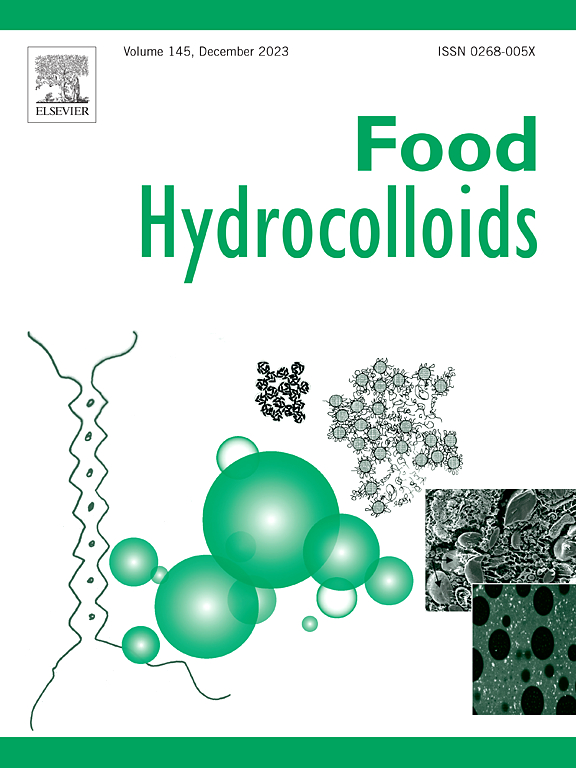球蛋白和白蛋白在油水界面中的作用及脉冲蛋白的乳状稳定性
IF 11
1区 农林科学
Q1 CHEMISTRY, APPLIED
引用次数: 0
摘要
脉冲蛋白提取物在食品应用中受到了相当大的关注,例如,作为乳化剂。这些提取物是主要由球蛋白和白蛋白组成的复杂蛋白质混合物,但这些单独的蛋白质组分如何影响乳化特性仍然知之甚少。本研究从扁豆、蚕豆和鹰嘴豆中分离出球蛋白和白蛋白,并系统地研究了它们在油水界面和乳状液稳定中的作用。我们确定了这些脉冲蛋白(包括全蛋白混合物)的关键分子和界面参数,这些参数在乳液稳定中是重要的。具有低变性焓的脉冲蛋白(脉冲白蛋白的一个特点)倾向于生成较小的油滴,这很可能是由于它们的粒径较小(4-5 nm),这使得蛋白质在油水界面上密集堆积,并促进了刚性蛋白质网络结构的形成,有助于在均质过程中/后稳定新生成的油滴。高的热稳定性,如在脉冲豆蛋白球蛋白中观察到的那样,不利于界面刚度,并且由于缺乏蛋白质-蛋白质在平面内的相互作用,界面网络结构对大变形的抵抗力,并且在高剪切共混下往往具有低的乳液稳定性。在乳液储存过程中,脉冲白蛋白在整个蛋白质混合物中也容易引起液滴絮凝/聚结,这可能是由于其表面电荷低,粒径较小,无法提供足够的静电和空间斥力。总的来说,白蛋白在高剪切共混下主导脉冲蛋白的乳状稳定性,而球蛋白则主导乳状储存稳定性。该研究有助于指导脉冲蛋白的筛选,使其具有理想的乳化性能。提出的关键分子和界面参数可用于进一步建模,例如,基于人工智能,以更好地理解和预测多相系统中脉冲蛋白的功能。本文章由计算机程序翻译,如有差异,请以英文原文为准。

Role of globulins and albumins in oil-water interface and emulsion stabilization properties of pulse proteins
Pulse protein extracts have received considerable attention in food applications, for instance, as emulsifiers. These extracts are complex protein mixtures consisting primarily of globulins and albumins, but how these individual protein fractions affect the emulsifying properties is still poorly understood. In this study, we separated globulins and albumins from lentil, faba bean and chickpea, and systematically investigated their role in the stabilization of oil-water interfaces and emulsions. We identified key molecular and interfacial parameters of these pulse proteins (including the whole protein mixtures) which are important in emulsion stabilization. Pulse proteins with low denaturation enthalpy, a feature of the pulse albumins, tend to generate smaller oil droplets, most likely due to their small particle size (4–5 nm) which enables dense pack of proteins at the oil-water interface and promote the formation of stiff protein network structure that helps to stabilize the newly generated oil droplets during/after homogenization. High thermal stability, as observed in pulse legumin globulins, is detrimental to the interfacial stiffness, and the resistance of the interfacial network structure to large deformations due to the lack of protein-protein in-plane interactions and tend to give low emulsion stability under high shear blending. During emulsion storage, pulse albumins tend to cause droplet flocculation/coalescence also in the whole protein mixtures, likely due to their low surface charge and smaller particle size that could not provide enough electrostatic and steric repulson. Overall, albumins dominate the emulsion stability of pulse proteins under high shear blending, and globulins dominate the emulsion storage stability. This study may help to guide the screening of pulse proteins for desired emulsifying properties. The proposed key molecular and interfacial parameters could be used for further modeling, for example, based on artificial intelligence, to better understand and predict the functionalities of pulse proteins in multiphase systems.
求助全文
通过发布文献求助,成功后即可免费获取论文全文。
去求助
来源期刊

Food Hydrocolloids
工程技术-食品科技
CiteScore
19.90
自引率
14.00%
发文量
871
审稿时长
37 days
期刊介绍:
Food Hydrocolloids publishes original and innovative research focused on the characterization, functional properties, and applications of hydrocolloid materials used in food products. These hydrocolloids, defined as polysaccharides and proteins of commercial importance, are added to control aspects such as texture, stability, rheology, and sensory properties. The research's primary emphasis should be on the hydrocolloids themselves, with thorough descriptions of their source, nature, and physicochemical characteristics. Manuscripts are expected to clearly outline specific aims and objectives, include a fundamental discussion of research findings at the molecular level, and address the significance of the results. Studies on hydrocolloids in complex formulations should concentrate on their overall properties and mechanisms of action, while simple formulation development studies may not be considered for publication.
The main areas of interest are:
-Chemical and physicochemical characterisation
Thermal properties including glass transitions and conformational changes-
Rheological properties including viscosity, viscoelastic properties and gelation behaviour-
The influence on organoleptic properties-
Interfacial properties including stabilisation of dispersions, emulsions and foams-
Film forming properties with application to edible films and active packaging-
Encapsulation and controlled release of active compounds-
The influence on health including their role as dietary fibre-
Manipulation of hydrocolloid structure and functionality through chemical, biochemical and physical processes-
New hydrocolloids and hydrocolloid sources of commercial potential.
The Journal also publishes Review articles that provide an overview of the latest developments in topics of specific interest to researchers in this field of activity.
 求助内容:
求助内容: 应助结果提醒方式:
应助结果提醒方式:


